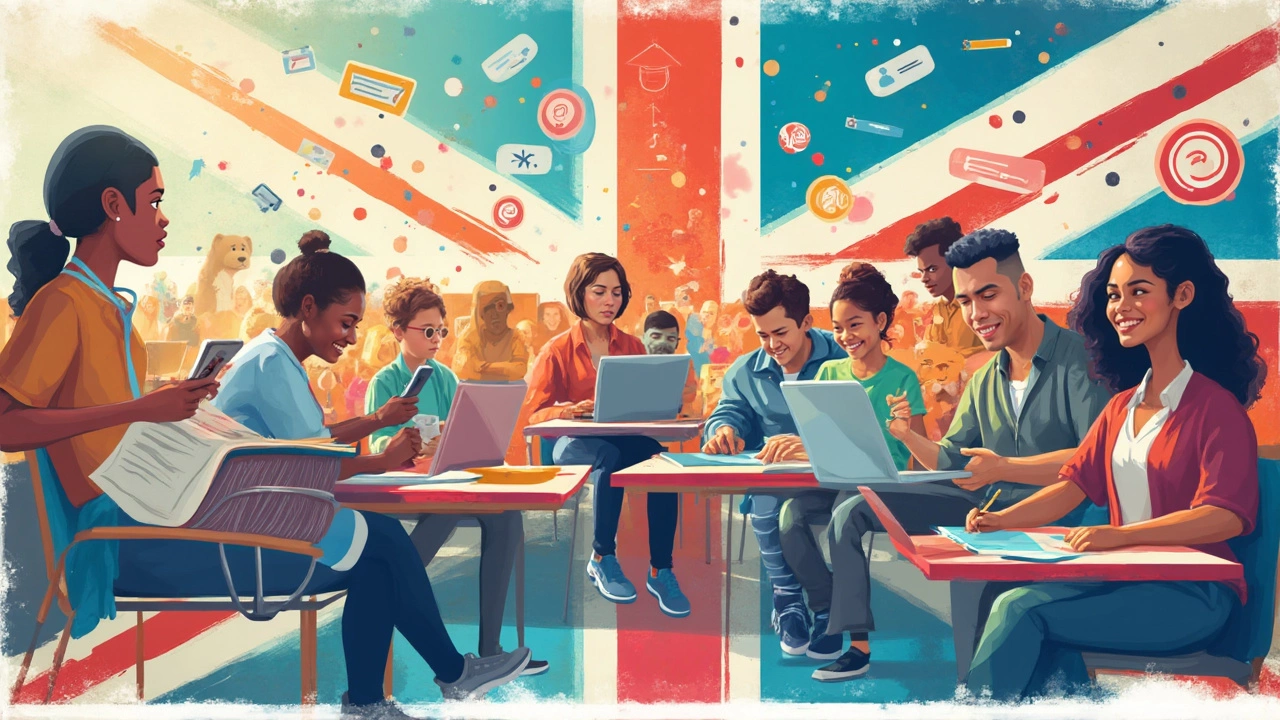-
28
- 0

Open and Distance Learning: How It Works and Why It Matters
A lot of people think learning only happens in stuffy classrooms with desks, but the world of open and distance learning blows that idea out of the water. Imagine being able to take a college course from your kitchen table, or finish a certification while riding the train. That’s the core of open and distance learning—it lets you access education from wherever you are, whether that’s home, work, or the local coffee shop.
This kind of learning isn’t brand new. Even before the internet, students would get lessons through the mail, work on them at home, and send them back for grading. These days, it’s all about online courses, video lessons, email assignments, and even live chat sessions with your teacher. You don’t have to live near a particular school or fit your life around strict class times anymore. If you ever wanted to learn a new skill but didn’t think you had the time or opportunity, open and distance learning is a game-changer.
What counts as distance learning, anyway? You’ll see it called remote learning, online study, or open learning, but it all means the same thing: students and teachers aren’t in the same place at the same time. It’s flexible, it works for different lifestyles, and it’s less about old-fashioned rules and more about getting people the knowledge they want, the way that fits them best.
- What Exactly Is Open and Distance Learning?
- How Learning Works Without Walls
- Biggest Perks—and a Few Surprises
- Tips for Getting the Most Out of Distance Learning
What Exactly Is Open and Distance Learning?
Open and distance learning (ODL) is all about making education available to just about anyone, no matter where they live, how old they are, or what their schedule looks like. The “open” part usually means there aren’t tough entry requirements—you don’t always need top grades or specific qualifications to join. The “distance” part means you’re not sitting in a traditional classroom, but learning in your own space and at your own pace, often online.
This approach started way before the internet, with mail-based courses (think big packets of lessons sent to your door). With today’s tech, it’s exploded into anything from smartphone-friendly micro-courses to full university degrees done over video calls, email, and interactive platforms. The common thread? The student and teacher don’t have to be together in person, ever.
- Online education platforms like Coursera, Open University, and edX are prime examples of ODL in action—they offer courses that you can start anytime, finish at your speed, and access from pretty much anywhere with Wi-Fi.
- Some schools mix online materials with occasional in-person meet-ups, but pure remote learning happens 100% off-campus.
- ODL is used by working professionals, parents with busy schedules, and anyone who wants to avoid commuting or changing their lifestyle for school.
Fun fact: More than 6.5 million students in the U.S. alone took at least one online education course in recent years, and this number keeps rising because of how flexible and accessible it is.
Here’s what usually stands out in open and distance learning:
- You choose when and how fast you study.
- All learning materials—videos, readings, tests—are digital or mailed to you.
- Help is available through forums, email, live chat, or sometimes phone calls.
- Exams and assignments can often be done remotely, too.
ODL breaks down the usual barriers. It’s not about where you live, but what you want to learn and how you want to make it fit into your life.
| Feature | Traditional Learning | Open & Distance Learning |
|---|---|---|
| Location | On campus | Anywhere with internet |
| Class Times | Fixed schedule | Flexible, self-paced |
| Entry Requirements | Strict | Often open |
| Interaction | Face-to-face | Online or remote |
| Materials | Physical | Digital/Mailed |
How Learning Works Without Walls
So, what does it actually look like when you do distance learning instead of hitting a physical classroom? Most of the action happens online. Colleges and schools use platforms like Moodle, Blackboard, Canvas, or even Google Classroom to organize courses. This is where you’ll find your lessons, assignments, quizzes, and grades all in one spot. Some schools will add video meetings on Zoom or Teams, so even though you’re not face-to-face, you still get to interact in real time.
Not everything’s live, though. In fact, a big plus of online education is being able to hit 'pause' when you need a break. Most materials are available 24/7. You might watch pre-recorded lectures, download notes, and message your instructor or classmates in discussion boards whenever it fits your day.
Here are the typical ways you’ll experience open and remote learning:
- Self-paced Courses: Move through the material as fast or slow as you want—no one’s waiting for you to catch up.
- Scheduled Online Classes: Log in for live sessions with classmates and your teacher, just like a regular class, but through your laptop.
- Interactive Assignments: This can mean replying to class discussions, doing group projects in virtual rooms, or submitting digital assignments for feedback.
- Online Tests and Quizzes: Sometimes timed, sometimes not, but all taken from the device of your choice.
If you're curious about how common this setup has become, check this out:
| Year | Students Enrolled in Distance Learning (U.S.) |
|---|---|
| 2012 | 6.7 million |
| 2022 | Over 14 million |
This doubling in a decade tells you everything about how popular and normal flexible study is now. People use it to finish degrees, switch careers, or just pick up new skills everyone’s asking for—without ever setting foot on campus.

Biggest Perks—and a Few Surprises
It’s hard to top the flexibility of distance learning. You’re not tied to one city or even a daily schedule. This makes it perfect if you’re juggling a job, raising kids, or just want to study at your own speed. No fighting traffic to get to class, and you can log in when it works for you—even at midnight in your pajamas.
Another big win: money. A lot of online education programs chop out costs like campus housing, commuting, and even pricey printed materials. One study by the Babson Survey Research Group found that most online courses cost 6-12% less than face-to-face options for the same subjects. And sometimes, open learning courses are free—if you just want the knowledge and not a printed certificate.
Open and distance learning also connects you with people all over the world. It’s not rare to be in a virtual classroom with classmates from Brazil, Japan, or Nigeria, swapping ideas and solving problems together. This global vibe makes the learning richer (and way more interesting) than just sticking to your local area.
- Self-paced learning: Go through modules at your own speed. Fall behind? You can catch up without getting side-eye from classmates.
- Wide course selection: Pick from a massive range of programs, from business to coding to philosophy. If you can dream it, there’s likely a remote course for it.
- More accessible: People with disabilities, or those living in remote areas, aren’t left out. If you’ve got internet, you get the same shot as anyone else.
But it’s not all smooth sailing. One surprise: motivation can be tough. Nobody’s going to chase you for late homework, so if you tend to procrastinate, keeping up can be a real challenge. Also, some students miss the instant feedback and daily interactions you get in a regular classroom. A lot of distance learning happens on screens, which can feel isolating if you aren’t ready for it.
| Perk | How It Helps |
|---|---|
| Flexibility | Study anytime, anywhere |
| Cost Savings | Lower tuition, no travel or housing |
| Global Access | Learn with peers from around the world |
| Accessibility | Open to those with mobility or location challenges |
If you’re eyeing open and distance learning as an option, take a look at these perks—and weigh them against your own personality and needs. It’s not perfect for everyone, but for those who want control, variety, and affordability, it’s hard to beat.
Tips for Getting the Most Out of Distance Learning
Getting serious about distance learning can totally pay off, but it’s easy to slip unless you set yourself up right. Without classmates around or a teacher checking up on you, you’re in the driver’s seat. Here’s how to get the most from your online or open learning experience.
- Create a routine: Set regular study times during your week. Even 30 minutes here and there works better than “whenever I get the chance.” Having a plan makes it harder to put things off.
- Choose your study spot wisely: Try to pick a spot where you won’t get distracted. This can be a certain chair, a library corner—wherever you feel you focus best.
- Stay connected: Most distance learning courses offer forums, live chats, or group projects. Jump in and interact. You’ll not only learn more, but you’ll also feel less alone.
- Break up big assignments: Tackling a paper or project last minute is tempting, but splitting it into small tasks helps you stay on track and reduces stress.
- Keep track of deadlines: Mark important dates right away—set calendar reminders. A lot of online courses don’t give you many reminders, and it’s easy to miss things.
- Don't be afraid to ask for help: Shoot your instructor an email if you’re stuck. Most are quick to help and actually want students to reach out.
One study by the National Center for Education Statistics (2023) found that 72% of students who set a weekly learning schedule were more likely to finish their online education programs than those who didn’t plan at all.
| Tip | Why It Works |
|---|---|
| Stick to a routine | Helps build lasting study habits and keeps you accountable |
| Join online discussions | Boosts understanding and motivation |
| Plan ahead for deadlines | Reduces last-minute panic and lowers dropout risk |
Taking remote learning seriously means treating it like a real commitment. Schedule your time, connect with others, ask questions, and chip away at your work instead of letting it pile up. You’ll actually enjoy the ride—and the freedom.
Write a comment
Tags Weight
- education
- study tips
- adult education
- exam preparation
- online courses
- adult learning
- lifelong learning
- distance learning
- GCSE revision
- online education
- private tutoring
- special needs education
- scholarships
- remote learning
- scholarship tips
- financial aid
- international students
- effective learning
- e-learning
- education funding

Written by Elara Winslow
View all posts by: Elara Winslow